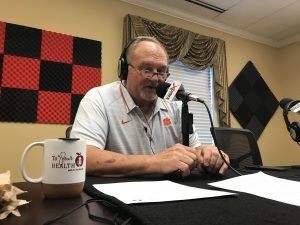

Covid-19 Vaccine Development – Episode 39, To Your Health With Dr. Jim Morrow
On this edition of “To Your Health,” Dr. Morrow talks about the potential for a Covid-19 vaccine and the path of its development. Dr. Morrow also gives his thoughts on starting this fall’s college football season. “To Your Health” is brought to you by Morrow Family Medicine, which brings the CARE back to healthcare.
About Morrow Family Medicine and Dr. Jim Morrow
Morrow Family Medicine is an award-winning, state-of-the-art family practice with offices in Cumming and Milton, Georgia. The practice combines healthcare information technology with old-fashioned care to provide the type of care that many are in search of today. Two physicians, three physician assistants and two nurse practitioners are supported by a knowledgeable and friendly staff to make your visit to Morrow Family Medicine one that will remind you of the way healthcare should be. At Morrow Family Medicine, we like to say we are “bringing the care back to healthcare!” Morrow Family Medicine has been named the “Best of Forsyth” in Family Medicine in all five years of the award, is a three-time consecutive winner of the “Best of North Atlanta” by readers of Appen Media, and the 2019 winner of “Best of Life” in North Fulton County.
Dr. Jim Morrow, Morrow Family Medicine, and Host of “To Your Health With Dr. Jim Morrow”
 Dr. Jim Morrow is the founder and CEO of Morrow Family Medicine. He has been a trailblazer and evangelist in the area of healthcare information technology, was named Physician IT Leader of the Year by HIMSS, a HIMSS Davies Award Winner, the Cumming-Forsyth Chamber of Commerce Steve Bloom Award Winner as Entrepreneur of the Year and he received a Phoenix Award as Community Leader of the Year from the Metro Atlanta Chamber of Commerce. He is married to Peggie Morrow and together they founded the Forsyth BYOT Benefit, a charity in Forsyth County to support students in need of technology and devices. They have two Goldendoodles, a gaggle of grandchildren and enjoy life on and around Lake Lanier.
Dr. Jim Morrow is the founder and CEO of Morrow Family Medicine. He has been a trailblazer and evangelist in the area of healthcare information technology, was named Physician IT Leader of the Year by HIMSS, a HIMSS Davies Award Winner, the Cumming-Forsyth Chamber of Commerce Steve Bloom Award Winner as Entrepreneur of the Year and he received a Phoenix Award as Community Leader of the Year from the Metro Atlanta Chamber of Commerce. He is married to Peggie Morrow and together they founded the Forsyth BYOT Benefit, a charity in Forsyth County to support students in need of technology and devices. They have two Goldendoodles, a gaggle of grandchildren and enjoy life on and around Lake Lanier.
Facebook: https://www.facebook.com/MorrowFamMed/
LinkedIn: https://www.linkedin.com/company/7788088/admin/
Twitter: https://twitter.com/toyourhealthMD
The complete show archive of “To Your Health with Dr. Jim Morrow” addresses a wide range of health and wellness topics, and can be found at www.toyourhealthradio.com.
Dr. Morrow’s Show Notes
Episode 39: Vaccinating Against Sars-Co-V2
My take on college football before a vaccine:
If a college allows students to be on campus, I can’t see why they would not allow football and other sports to be played. The players are at no more risk than the students when they attend house parties and other social functions where we all know many will not be distancing or wearing masks.
If a college does not allow students on campus, then I can’t see how they can allow players to get together and practice and play. The risk is the same for both groups and just because the football players generate an enormous amount of money for the school and the town, they should not be out to risk greater than the average student is exposed to.
I believe that if colleges test enough, prefer daily, then games could be safely played. But absolutely every person who will be on the field should be tested the day of the game. I don’t know enough about the logistics of testing yet to know how that would be done, but I do know from the testing machine that we plan to implement at Morrow Family Medicine that it is possible if your pockets are deep enough. And these colleges pockets are plenty deep.
Generalities About Vaccines
- To make a vaccine, you must know what it is about an infectious agent that makes your body respond to it.
- What makes you create antibodies?
- With SarsCoV-2, it appears to be the spike protein.
- That is the part that creates the crown-like appearance that gives it the name coronavirus.
- When it attaches to your body, it creates proteins that are foreign and cause the problems you have from the infection.
- If we can introduce the spike protein into your body without the viral mechanism,
- then you can create antibodies to the virus without getting an infection.
- If you are later exposed to the virus itself,
- you have the antibodies already in place,
- they attach to the spike protein
- and prevent infection.
- That is a gross simplification of the process, but I think it makes the point.
- Up till now, the fastest we were able to make a vaccine was a little over four years –
- that was the mumps vaccine.
- Now, in this pandemic, all of our vaccine related infrastructure has been pointed to making this vaccine.
- Because of that, the entire process will be much faster for this vaccine.
- There are currently two main types of vaccines being developed.
- One is in mRNA vaccine that has never been developed before.
- The other is an adenovirus vaccine that is similar to some vaccines in the past.
- This vaccine uses a chimpanzee common cold virus and there will be elements of the coronavirus genome inserted into that virus.
- In both cases the vaccine will create proteins in the body that will cause antibodies to be produced which would recognize the coronavirus should you be infected.
What’s So Difficult About Vaccines
- Since humans haven’t previously been exposed to the novel coronavirus (SARS-CoV-2), our bodies aren’t well equipped to deal with being infected by it.
- A vaccine would allow the body to safely develop an immune response to COVID-19 that could prevent or control infection.
- But it takes time to develop safe and effective vaccines –
- usually five to ten years on average.
- Despite promising reports about potential coronavirus vaccines being developed worldwide,
- it could still take an estimated 12-18 months to develop one.
- It’s becoming quicker to develop new vaccines than it was in the past
- as we can build on research from vaccines used for other diseases.
- During outbreaks, more resources and funding may also become available,
- which can speed up the process.
- Products might also be considered for use even before being formally granted licenses to control the disease in severely affected areas during emergencies.
- The development of a potential novel coronavirus vaccine is being partly led by experts who were already developing vaccines for other coronaviruses.
- This type of virus was identified as a possible cause of the next big pandemicas the other coronaviruses SARS and MERS have been responsible for two global outbreaks in the last 20 years.
- Research on vaccines for these coronaviruses was already undergoing clinical trials.
- The first new vaccine to enter human trials for COVID-19was developed by the US firm Moderna Therapeutics.
- About 35 other companies and academic institutions are also working on COVID-19 vaccines.
- Most are currently in “pre-clinical testing”, including one being developed by a team of researchers at the University of Oxford.
- The vaccine candidate was identified in January and is nearing the clinical testing phase.
Steps to a Vaccine
Basic understanding of the virus
- In the past, most studies of human viruses looked at how the virus altered or affected human or animal cells in the lab.
- Scientists first identify the proteins and sugars on the surface of the viruses or infected cells,
- then study whether these proteins can be used to produce an immune response.
- In the present case, this stage was made easier for researchers after Chinese scientists found and published the genetic sequence of novel coronavirus in January.
- Researchers worldwide have been able to identify the structure of proteins that make up the virus,
- create a genetic history of the family of viruses,
- and determine when the first human was infected.
- It also enabled diagnostic testing kits to be developed, and lets researchers identify potential treatment options.
- Researchers worldwide have been able to identify the structure of proteins that make up the virus,
Vaccine candidates
- The process may involve isolating the live virus before inactivating or weakening it and
- then determining whether this modified virus,
- which is known as a vaccine candidate,
- might produce immunity in people.
- Sometimes the live virus is not part of the process.
- Instead, its genetic sequence is used to make the vaccine.
- The genetic sequence can also be used to make recombinant proteins,
- a vaccine production method that has been used before for vaccines like hepatitis B.
- Researchers now know how to manufacture and test the relevant vaccine
- and check it has been made properly.
- They even know about likely doses, including how many doses will be needed to build immunity.
- This background knowledge speeds up the development of each new vaccine made using the same technology.
Pre-clinical testing
- Initial safety testing is usually carried out in animals to give an idea of responses in humans.
- These are also used to see how effective the vaccine is at preventing the disease,
- and allows researchers to adapt the vaccine.
- During an outbreak, different research groups often work together to speed up this process.
Clinical trials – testing in humans
- This step is where many promising potential vaccines fail.
- There are three phases of a clinical trial:
- Phase 1: Testing on a few dozen healthy volunteers,
- looking at how safe the vaccine is,
- and if it has any adverse effects;
- Phase 2: Testing on several hundred people for efficacy, a “target population”
- who are ideally those most at risk of the disease;
- Thanks to Operation Warp Speed,
- a federally funded program to speed vaccine production,
- most companies are combining Phase 2 and Phase 3.
- Phase 2 is primarily performed to ensure the company that the vaccine they have developed will work on the target population.
- This is where many vaccines die,
- ending the spend for that company.
- If the company can avoid this phase,
- or combine it with Phase 3,
- they can save millions of dollars
- and also cut months or even years off of the process.
- Phase 3: Testing on several thousand people for efficacy and safety.
- Trials of 30,000 or more people are required in Phase 3.
- Russia has recently released a vaccine without going through Phase 3,
- setting off all kinds of alarms in the scientific community.
- Through these phases the vaccine needs to show it’s safe,
- leads to a strong immune response,
- and provides effective protection against the virus.
- During an outbreak, experimental vaccines may be used in severely affected populations if they’re at high risk of disease, before progressing to regulatory approval
- This is where many vaccines die,
- Phase 1: Testing on a few dozen healthy volunteers,
Production
- Once a vaccine has been produced at a small scale and passed safety tests, it can be used in clinical trials.
- However, significant manufacturing capacity,
- such as infrastructure,
- personnel
- and equipment,
- will be needed to produce large quantities of a vaccine for use.
- Quality control is also needed.
- All of these processes are very carefully monitored.
- Once licensed, policy must be developed to decide how to prioritize those who should be vaccinated, such as those in the most high-risk groups and locations.
- Along the way, if any of these vaccine “candidates” are shown to be unsafe or ineffective,
- researchers must return to the laboratory to develop a new candidate.
- This is why vaccine development can be a long and uncertain process.
- However, significant manufacturing capacity,














